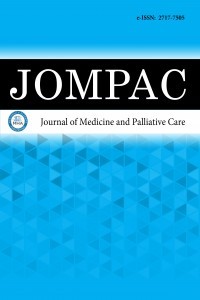Epikardiyal yağ dokusu ve hepatosteatoz ile koroner ateroskleroz arasındaki ilişkinin çok kesitli bilgisayarlı tomografi ile değerlendirilmesi
Koroner Ateroskleroz, Epikardiyal Yağ Doku, Hepatosteatoz, ÇKBT
Evaluation of the relation between epicardial adipose tissue and hepatosteatosis with coronary atherosclerosis using multidetector computed tomography
Coronary atherosclerosis, Epicardial adipose tissue, Hepatosteatosis, MDCT,
___
- Kershaw EE, Flier JS. Adipose tissue as an endocrine organ. J Clin Endocrinol Metab 2004; 89: 2548–56.
- Iacobellis G, Leonetti F, Mario UD. Images in cardiology: massive epicardial adipose tissue indicating severe visceral obesity. Clin Cardiol 2003; 26: 237.
- Sharma AM. Adipose tissue: a mediator of cardiovascular risk. Int J Obes Relat Metab Disord 2004; 26: S5–S7.
- Carr DB, Utzschneider KM, Hull RL, et al. Intra-abdominal fat is a major determinant of the National Cholesterol Education Program Adult Treatment Panel III criteria for the metabolic syndrome. Diabetes 2004; 53: 2087–94.
- Yusuf S, Hawken S, Ounpuu S et al. Obesity and the risk of myocardial infarction in 27,000 participants from 52 countries: A case-control study. Lancet 2005 Nov 5; 366: 1640-9.
- Kremen J, Dolinkova M, Krajickova J, et al. Increased subcutaneous and epicardial adipose tissue production of procytokines in cardiac surgery patients: possible role in postoperative insulin resistance. J Clin Endocrinol Metab 2006; 91: 4620-7.
- Libby P, Ridker PM, Maseri A. Inflammation and atherosclerosis. Circulation 2002; 105: 1135-43.
- Iacobellis G, Ribaudo MC, Assael F, et al. Echocardiographic epicardial adipose tissue is related to anthropometric and clinical parameters of metabolic syndrome: A new indicator of cardiovascular risk. J Clin Endocrinol Metab 2003; 88: 5163-8.
- Mazurek T, Zhang L, Zalewski A, et al. Human epicardial adipose tissue is a source of mediators. Circulation 2003; 108: 2460-6.
- Rabkin SW. Epicardial fat: properties, function and relationship to obesity. Obes Rev 2007; 8: 253-61.
- Baker AR, Silva NF, Quinn DW, et al. Human epicardial adipose tissue expresses a pathogenic profile of adipocytokines in patients with cardiovascular disease. Cardiovasc Diabetol 2006; 5: 1.
- de Vos AM, Prokop M, Roos CJ, et al. Peri-coronary epicardial adipose tissue is related to cardiovascular risk factors and coronary artery calcification in postmenopausal women. Eur Heart J 2008; 29: 777 – 83.
- Chaowalit N, Somers VK, Pellikka PA, Rihal CS, Lopez-Jimenez F. Subepicardial adipose tissue and the presence and severity of coronary artery disease. Atherosclerosis 2006; 186: 354-9.
- Jeong JW, Jeong MH, Yun KH, et al. Echocardiographic epicardial fat thickness and coronary artery disease. Circ J 2007; 71: 536-9.
- Djaberi R, Schuijf JD, van Werkhoven JM, Nucifora G, Jukema JW, Bax JJ. Relation of epicardial adipose tissue to coronary atherosclerosis. Am J Cardiol 2008; 102: 1602–7.
- Wu FZ, Chou KJ, Huang YL, Wu MT. The relation of location-specific epicardial adipose tissue thickness and obstructive coronary artery disease: systemic review and meta-analysis of observational studies. BMC Cardiovasc Disord 2014; 14:62.
- Vega GL, Chandalia M, Szczepaniak LS, Grundy SM. Metabolic correlates of nonalcoholic fatty liver in women and men. Hepatology 2007; 46: 716-22.
- Shores NJ, Link K , Fernandez A, et al. Non-contrasted computed tomography for the accurate measurement of liver steatosis in obese patients. Dig Dis Sci. 2011; 56: 2145–51.
- Iacobellis G, Assael F, Ribaudo MC, et al. Epicardial fat from echocardiography: a new method for visceral adipose tissue prediction. Obes Res 2003; 11: 304–10.
- Ahn SG, Lim HS, Joe DY, et al. Relationship of epicardial adipose tissue by echocardiography to coronary artery disease. Heart 2008; 94: e7.
- Sarin S, Wenger C, Marwaha A, et al. Clinical significance of epicardial fat measured using cardiac multislice computed tomography. Am J Cardiol 2008; 102: 767–71.
- Demircelik MD, Yilmaz OÇ, Gurel OM, et al. Epicardial adipose tissue and pericoronary fat thickness measured with 64-multidetector computed tomography: potential predictors of the severity of coronary artery disease. Clinics 2014; 69: 388- 92.
- Rumberger JA, Brundage BH, Rader DJ, Kondos G. Electron beam computed tomographic coronary calcium scanning: a review and guidelines for use in asymptomatic individuals. Mayo Clin Proc. 1999; 74: 243–52.
- Raggi P. Coronary calcium on electron beam tomography imaging as a surrogate marker of coronary artery disease. Am J Cardiol 2001; 87: 27A-34A.
- Alper AT, Hasdemir H, Sahin S, et al. The relationship between nonalcoholic fatty liver disease and the severity of coronary artery disease in patients with metabolic syndrome. Turk Kardiyol Dern Ars. 2008; 36: 376- 81.
- Matteoni CA, Younossi ZM, Gramlich T, Boparai N, Liu YC, McCullough AJ. Nonalcoholic fatty liver disease: a spectrum of clinical and pathological severity. Gastroenterology 1999; 116: 1413- 19.
- Başlangıç: 2020
- Yayıncı: MediHealth Academy Yayıncılık
Meme kanseri subgruplarının sıklığı ve otoimmün tiroid hastalığının prognoz üzerine etkisi
Ramazan COŞAR, Aydın ÇİFCİ, Selim YALÇIN, Aşkın GÜNGÜNEŞ, Şenay ARIKAN DURMAZ
Elif UZUN ATA, Nilgün IŞIKSALAN ÖZBÜLBÜL
Sağlık kuruluna engellilik oranlarının belirlenmesi için başvuran hastaların retrospektif analizi
Ismet Serhat KAHYA, İlhan UYANER, Abdullah KESKİN, Mustafa Engin ŞAHİN, Ibrahım Serdar KAHYA, Çiğdem ÖZDİLEKCAN, Tarkan ÖZDEMİR
Neziha YILMAZ, Reyhan ÖZTÜRK, Murat KORKMAZ, Çiğdem KADER, Mehmet BALCI, Hafize KIZILKAYA, Salih CESUR, Seda SABAH ÖZCAN
Bir olgu nedeniyle varicella zoster ensefaliti ve tüberküloz menenjit birlikteliği
Salih CESUR, Fatoş ERSOY, Merve SARI, Cigdem ATAMAN HATİPOGLU, Esra KAYA KILIÇ, Sami KINIKLI
